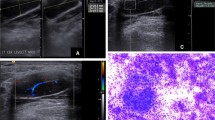Abstract
Objectives
To determine the efficacy of real-time elastography (RTE), compared with our previously proposed prediction model, in the detection of malignancy in cervical lymph nodes (LNs).
Methods
One hundred and thirty-one patients underwent ultrasound-guided fine needle aspiration biopsy (ultrasound FNAB) after ultrasound and RTE evaluation. The formula of the RTE scoring system was a four-point visual scale, based on a previously determined model. The formula of the prediction model was: \( 0.06\times \left( {\mathrm{age}} \right)+4.76\times \left( {{{{\mathrm{short}-\mathrm{axis}}} \left/ {{\mathrm{long}-\mathrm{axis}\;\mathrm{ratio}}} \right.}} \right)+2.15\times \left( {\mathrm{internal}\;\mathrm{echo}} \right)+1.80\times \left( {\mathrm{vascular}\;\mathrm{pattern}} \right) \). An extended model was constructed with four previous predictors and elasticity scores, using a logistic regression model.
Results
Final histology revealed 77 benign and 54 malignant LNs. In the elasticity score system, sensitivity was 66.7 %, specificity was 57.1 %, the positive predictive value (PPV) was 52.2 % and the negative predictive value (NPV) was 71.0 %. In the prediction model system, sensitivity was 79.6 %, specificity was 92.2 %, the PPV was 87.8 % and the NPV was 86.6 %. When the extended and the original model were compared, the areas under the receiver operating characteristic curve (c-statistic) was 0.94 and 0.95, respectively (P > 0.05).
Conclusions
Qualitative RTE offers no additional value over conventional ultrasound in predicting malignancy in cervical LNs.
Key Points
• An ultrasound system can help in the assessment of cervical lymph nodes.
• Grey-scale and power Doppler ultrasound remain fundamental for neck nodal evaluation.
• Qualitative real-time elastography provided no additional value compared with current prediction models.





Similar content being viewed by others
References
Ahuja A, Ying M (2002) An overview of neck node sonography. Invest Radiol 37:333–342
Liao LJ, Wang CT, Young YH, Cheng PW (2010) Real-time and computerized sonographic scoring system for predicting malignant cervical lymphadenopathy. Head Neck 32:594–598
Lyshchik A, Higashi T, Asato R et al (2007) Cervical lymph node metastases: diagnosis at sonoelastography—initial experience. Radiology 243:258–267
Alam F, Naito K, Horiguchi J, Fukuda H, Tachikake T, Ito K (2008) Accuracy of sonographic elastography in the differential diagnosis of enlarged cervical lymph nodes: comparison with conventional B-mode sonography. AJR Am J Roentgenol 191:604–610
Bhatia KS, Cho CC, Yuen YH, Rasalkar DD, King AD, Ahuja AT (2010) Real-time qualitative ultrasound elastography of cervical lymph nodes in routine clinical practice: interobserver agreement and correlation with malignancy. Ultrasound Med Biol 36:1990–1997
Tan R, Xiao Y, He Q (2010) Ultrasound elastography: its potential role in assessment of cervical lymphadenopathy. Acad Radiol 17:849–855
Ying L, Hou Y, Zheng HM, Lin X, Xie ZL, Hu YP (2012) Real-time elastography for the differentiation of benign and malignant superficial lymph nodes: a meta-analysis. Eur J Radiol 81:2576–2584
Shi GH, Wang XM, Ou GC et al (2010) Comparative study of ultrasonic elastography with conventional ultrasonography in cervical lymph nodes [in Chinese]. Chin J Ultrasound Med 26:730–733
Teng DK, Wang H, Lin YQ, Sui GQ, Guo F, Sun LN (2012) Value of ultrasound elastography in assessment of enlarged cervical lymph nodes. Asian Pac J Cancer Prev 13:2081–2085
Lenghel LM, Bolboaca SD, Botar-Jid C, Baciut G, Dudea SM (2012) The value of a new score for sonoelastographic differentiation between benign and malignant cervical lymph nodes. Med Ultrason 14:271–277
Ishibashi N, Yamagata K, Sasaki H et al (2012) Real-time tissue elastography for the diagnosis of lymph node metastasis in oral squamous cell carcinoma. Ultrasound Med Biol 38:389–395
Steinkamp HJ, Cornehl M, Hosten N, Pegios W, Vogl T, Felix R (1995) Cervical lymphadenopathy: ratio of long- to short-axis diameter as a predictor of malignancy. Br J Radiol 68:266–270
Takashima S, Sone S, Nomura N, Tomiyama N, Kobayashi T, Nakamura H (1997) Nonpalpable lymph nodes of the neck: assessment with US and US-guided fine-needle aspiration biopsy. J Clin Ultrasound 25:283–292
Rubaltelli L, Proto E, Salmaso R, Bortoletto P, Candiani F, Cagol P (1990) Sonography of abnormal lymph nodes in vitro: correlation of sonographic and histologic findings. AJR Am J Roentgenol 155:1241–1244
Wu CH, Hsu MM, Chang YL, Hsieh FJ (1998) Vascular pathology of malignant cervical lymphadenopathy: qualitative and quantitative assessment with power Doppler ultrasound. Cancer 83:1189–1196
Landis JR, Koch GG (1977) An application of hierarchical kappa-type statistics in the assessment of majority agreement among multiple observers. Biometrics 33:363–374
McNeil BJ, Hanley JA (1982) The meaning and use of the area under a receiver operating characteristic (ROC) curve. Radiology 143:29–36
DeLong ER, DeLong DM, Clarke-Pearson DL (1988) Comparing the areas under two or more correlated receiver operating characteristic curves: a nonparametric approach. Biometrics 44:837–845
Hanley JA, McNeil BJ (1983) A method of comparing the areas under receiver operating characteristic curves derived from the same cases. Radiology 148:839–843
Akobeng A (2007) Understanding diagnostic tests 3: receiver operating characteristic curves. Acta Paediatr 96:644–647
Wu M, Chen H, Zheng X, Burstein DE (2011) Evaluation of a scoring system for predicting lymph node malignancy in ultrasound guided fine needle aspiration practice. Diagn Cytopathol. doi:10.1002/dc.21745
Royston P, Moons KG, Altman DG, Vergouwe Y (2009) Prognosis and prognostic research: developing a prognostic model. BMJ 338:b604
Bhatia KS, Cho CC, Tong CS, Yuen EH, Ahuja AT (2012) Shear wave elasticity imaging of cervical lymph nodes. Ultrasound Med Biol 38:195–201
Bhatia K, Tong CS, Cho CC, Yuen EH, Lee J, Ahuja AT (2012) Reliability of shear wave ultrasound elastography for neck lesions identified in routine clinical practice. Ultraschall Med 33:463–468
Acknowledgments
This work was supported by the National Science Council of the Republic of China (Grant NSC101-2314- B-418-002) and grants from the Far Eastern Memorial Hospital (FEMH-101-2314-B-418-002).
Author information
Authors and Affiliations
Corresponding author
Rights and permissions
About this article
Cite this article
Lo, WC., Cheng, PW., Wang, CT. et al. Real-time ultrasound elastography: an assessment of enlarged cervical lymph nodes. Eur Radiol 23, 2351–2357 (2013). https://doi.org/10.1007/s00330-013-2861-7
Received:
Revised:
Accepted:
Published:
Issue Date:
DOI: https://doi.org/10.1007/s00330-013-2861-7




